Looking for the best time to visit the Valley of Flowers but not sure which month to choose? This UNESCO World Heritage Site in the Chamoli district of Uttarakhand is known for its diverse array of colourful blooms, transforming its landscape with the seasons. From early summer’s early buds to the peak of the monsoon’s blooms and into autumn’s golden shades, the Valley of Flowers offers trekkers a unique opportunity to witness the true Himalayan beauty.
The valley opens for visitors from June and remains open until October. Whether you want to see a blooming valley under misty skies, enjoy quieter trails with the smell of petrichor, or experience colder days surrounded by picture-perfect meadows, each month brings its own charm to the Valley.
To find out the best time to visit the Valley of Flowers based on your trekking preferences, scroll down to learn more.
Table of Contents
Best Time to Visit the Valley of Flowers
The best time to visit the Valley of Flowers trek is from mid-July to mid-August. It is considered a monsoon trek, as its lush meadows display their full blooming potential. However, you can also visit this valley anytime between June through October, according to what suits you best:
Valley of Flowers in June
The Valley of Flowers opens up in June for visitors. Winter ends by this time, and you can see the remnants of the spring season in the Valley’s colourful landscape. You will find some of the early blooms and budding flowers with vast stretches of lush green meadows. The weather and temperature remains favourable for trekking, and light showers become more prominent around the last week of June. This is not a peak season, hence you will see fewer crowds on the trails.
The difficulty level remains moderate as the climate conditions remain dry. However, you may find residual snow on the trails, making them slippery and difficult to traverse. Overall, June is an ideal time for people seeking adventure and fewer crowds in the Valley of Flowers.
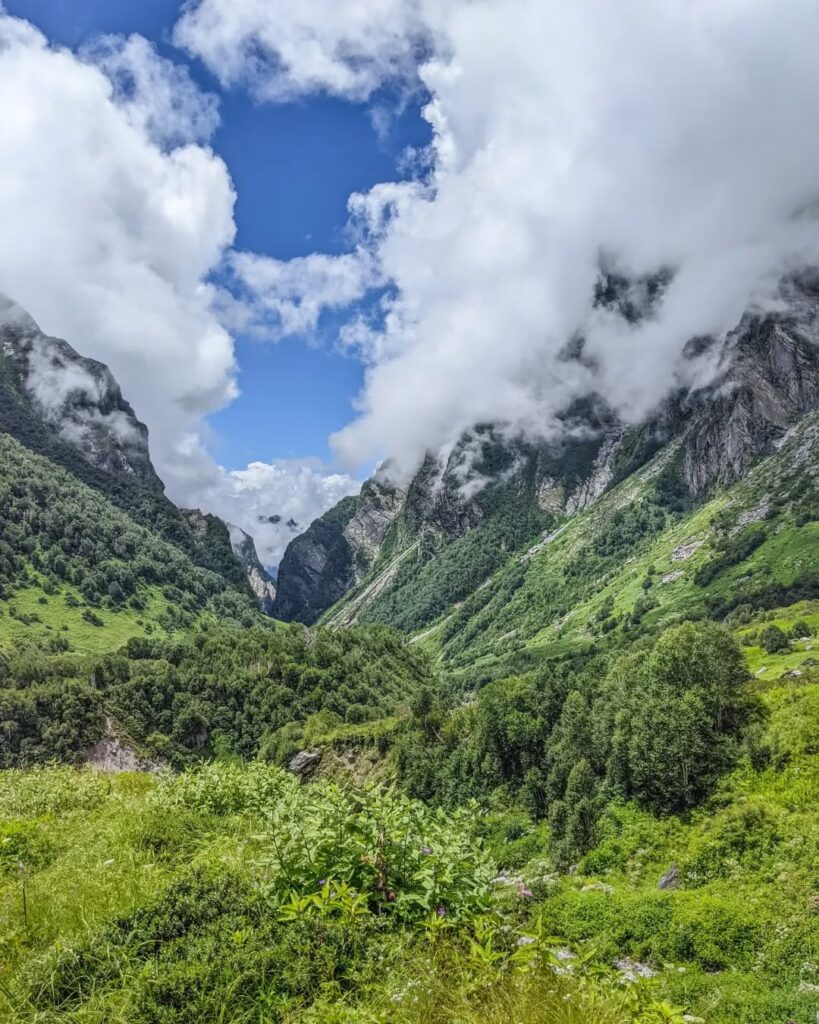
The table below highlights the main features of the Valley of Flowers in June:
| Attributes | Details |
| Temperature | 6°C / 16°C |
| Rain | Light rains in the last week of June |
| Weather | Pleasant weather during the day, with slightly chilly evenings and nights |
| Flowers | Mostly green landscape with a few buds of Primulas and Anemones showing early blooms |
| Crowd | Scanty crowd |
| Difficulty | Moderate |
| Ideal for | People looking for fewer crowds and a snow-covered landscape |
Pro Tip: Early-season trails still hold patches of melting snow and mud. So, pack waterproof gaiters or light hiking shoes with good ankle support.
Valley of Flowers in July
Monsoon arrives with the onset of July, bringing heavy and unpredictable rainfall in the Valley. In the first half, you will find early flowers like blue poppies and cobra lilies, blooming against a backdrop of fluorescent and bright green. By mid‑July, blooms color the entire Valley in the shades of pink, orange, red, and purple. Rain is usually light at higher altitudes, though Govindghat sees heavier showers. In July, you will find fewer trekkers as compared to August, offering a wholesome yet uncrowded experience.
With rain becoming more frequent and unpredictable, the difficulty remains moderate to difficult due to the risks of landslides, mudslides, and even floods. July is ideal for vacationers who want to visit this beautiful valley with their family or friends during the summer holidays. On clear days, you will get the beautiful views of the surrounding peaks, giving you one of the best experiences of trekking in the Valley.
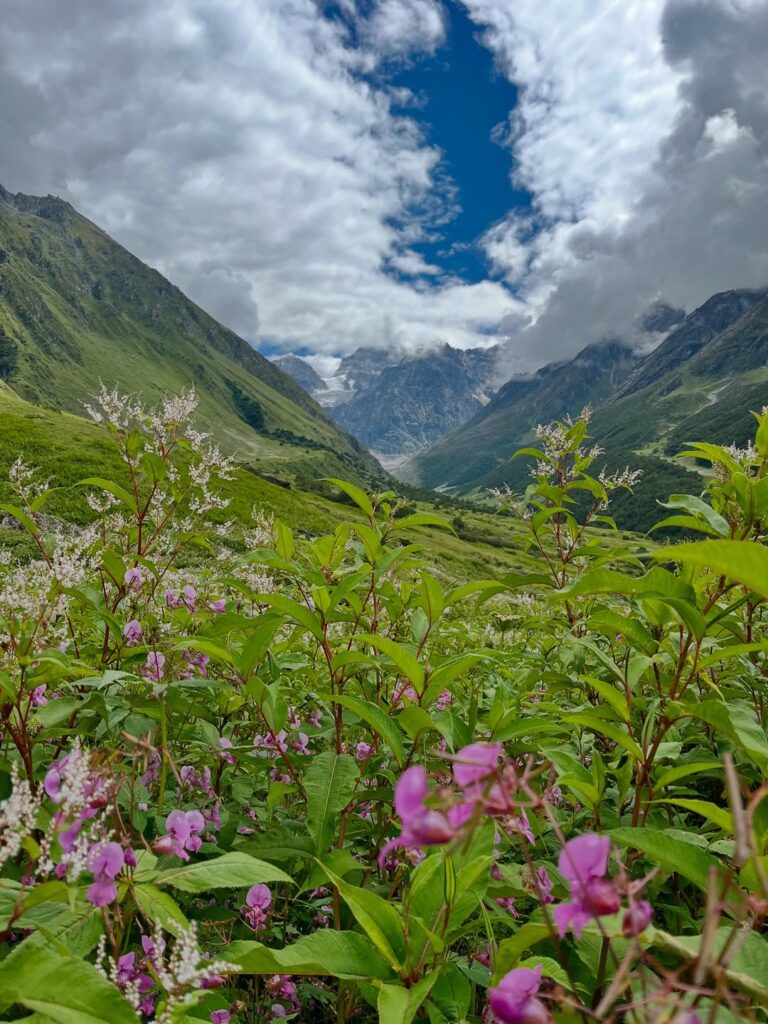
The table below highlights the main features of the Valley of Flowers in July:
| Attributes | Details |
| Temperature | 8°C / 20°C |
| Rain | Heavy rains after mid-July |
| Weather | Cool weather during the day with increased chances of rain during the evening and night. |
| Flowers | White anemones, Geraniums, Blue Poppies, Ladies Slipper Orchid, Golden Lily, Himalayan Bellflower |
| Crowd | Fewer crowds as compared to August |
| Difficulty | Moderate to difficult |
| Ideal for | Nature lovers, vacationers, and photographers seeking peaceful trekking and early floral blooms |
Pro Tip: Pack quick‑dry rain gear as afternoon showers are common, even if skies stay bright at higher altitudes. Start your day’s trek early (before 8 AM) to enjoy clearer views.
Valley of Flowers in August
Mid-July to mid-August is the peak bloom season in the Valley of Flowers. During early August, the Valley displays its full bloom, including notable species like primulas, balsams, and Himalayan orchids. Heavy monsoon rains can wilt petals later in the month, but drizzles at higher elevations keep the atmosphere trek-friendly.
The footfalls increase during August as its floral glory makes it the best time for photographers and nature lovers alike. Monsoon creates difficult-level trekking conditions in the lower reaches of the Valley, but the beauty of the misty landscape makes it worth the toil.
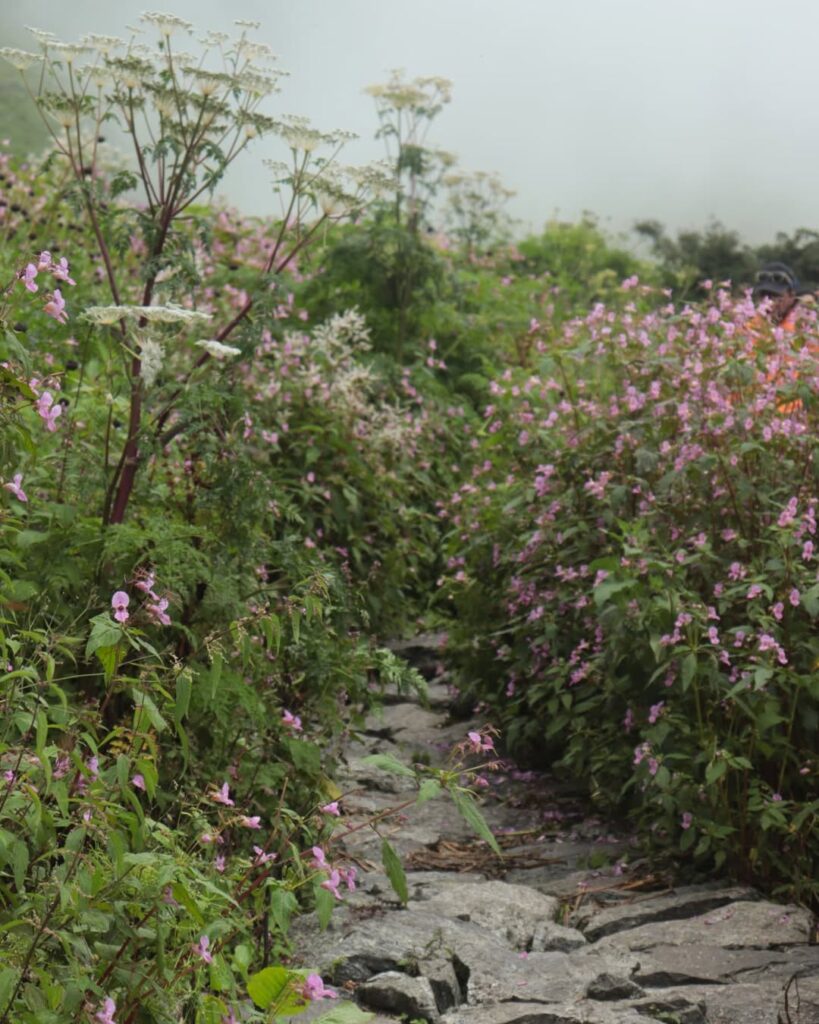
The table below highlights the main features of the Valley of Flowers in August:
| Attributes | Details |
| Temperature | 7°C / 24°C |
| Rain | Receives heavy rainfall, including mist and fog |
| Weather | Pleasant weather for trekking with cool temperatures |
| Flowers | Peak blooming season with Brahma Kamal, Himalayan Blue Poppy, cobra lilies, Primulas, Balsam, Orchids, and more. |
| Crowd | Peak tourist season in the valley |
| Difficulty | Moderate to difficult due to slippery trails and risks of landslides |
| Ideal For | Flower enthusiasts, photography lovers, vacationers, and botanists |
Pro Tip: Carry a lightweight umbrella or trekking pole with an umbrella attachment. Pack extra zip‑lock bags to protect electronics and snacks from moisture. Book accommodation in advance, since this is peak bloom season and local lodges fill up fast.
Valley of Flowers in September
By September, the monsoon retreats, making rain less frequent and drying out the trails. The number of blooms decreases by this time as most have wilted, but the valley remains lush and serene. Cooler days and clearer skies reveal panoramic mountain views. Pilgrims en route to Hemkund Sahib increase crowd levels, especially on weekends. However, the quieter early month still offers peaceful hikes amid autumn’s soft light.
This month is ideal for trekkers seeking a post-monsoon lush valley with clearer mountain views. The difficulty remains moderate as the climate remains favourable, giving safer trail conditions.
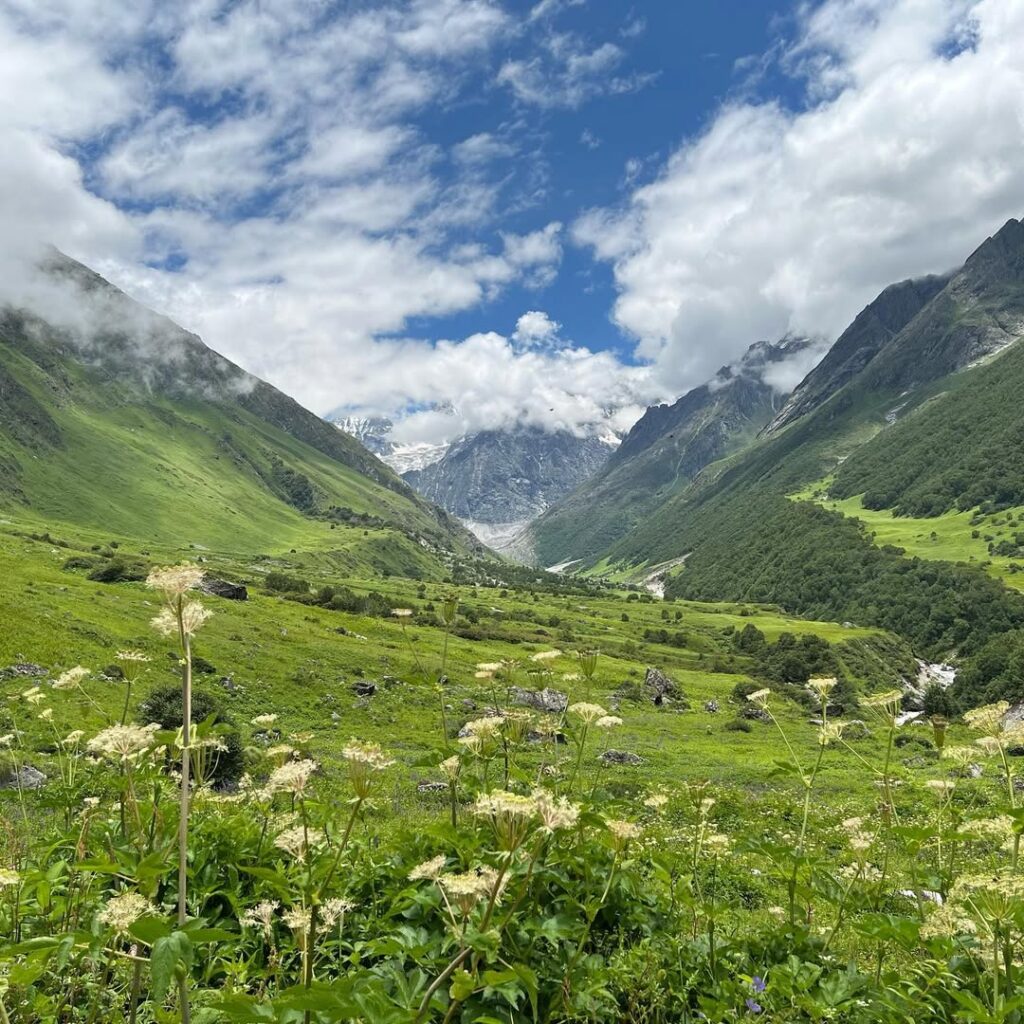
The table below highlights the main features of the Valley of Flowers in September:
| Attributes | Details |
| Temperature | 3°C / 23°C |
| Rain | Lesser rainfall by mid-September |
| Weather | Pleasant post-monsoon weather during the day, with colder evenings and nights |
| Flowers | Most flowers wilt by this time, you can find the remaining blooms at higher elevations, with some of them forming red or orange berries |
| Crowd | Peak pilgrimage season for Hemkund Sahib, and hence, footfall is heavy during September |
| Difficulty | Moderate |
| Ideal For | Hemkund Sahib pilgrimage, clear mountain views, and nature lovers |
Pro Tip: Layer up with a warm fleece or wool mid‑layer, even sunny afternoons can feel chilly in the valley. Plan your trek on weekdays if possible to share the trails mostly with pilgrims rather than tourist groups.
Valley of Flowers in October
By October, the Valley readies for the winter season. The autumn colours intensify the beauty of the Valley with shades of amber and brown against the backdrop of clear blue sky and towering peaks. You may find a few late flowers linger in sheltered pockets of the expansive meadow. The weather remains suitable for trekking with crisp mornings and mild afternoons.
With this being an off-season, you’ll enjoy solitude and stark beauty before snow blankets the valley from late October through March. The Valley of Flowers remains closed for the next 6-7 months due to harsh climate conditions.
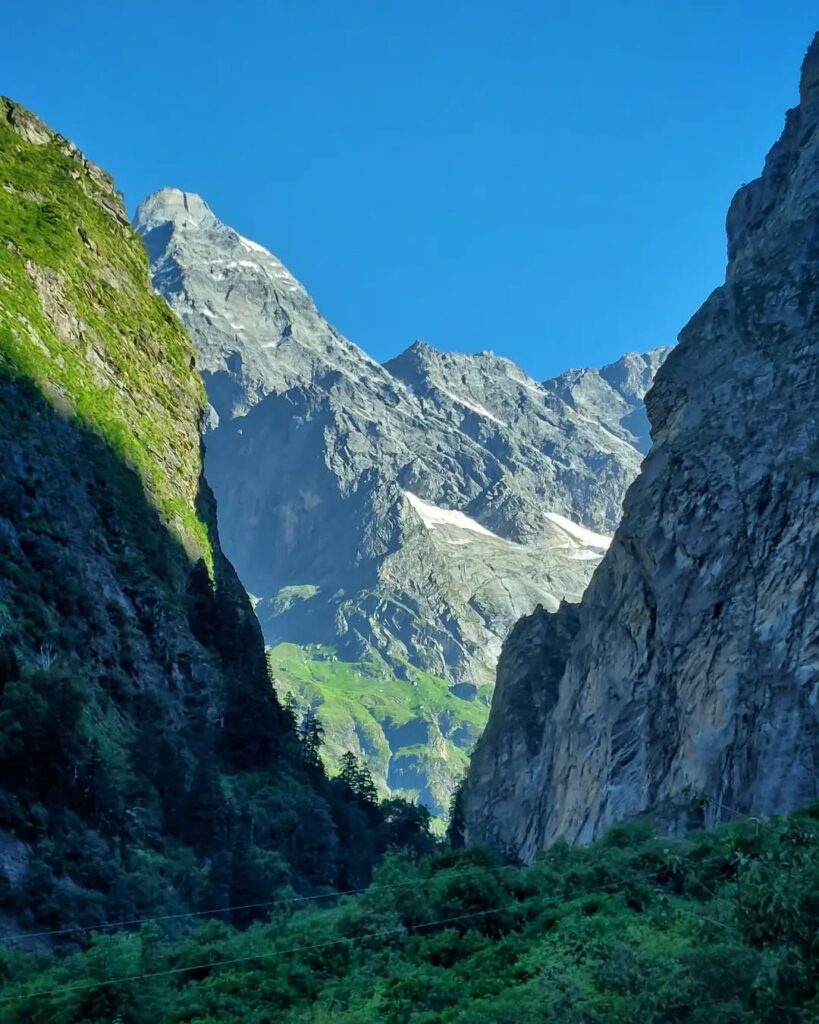
The table below highlights the main features of the Valley of Flowers in October:
| Attributes | Details |
| Temperature | 1°C / 17°C |
| Rain | Scanty and occasional rainfall |
| Weather | Cold weather conditions with the onset of autumn, with chilly days and nights |
| Flowers | Dried foliage and grasses due to autumn |
| Crowd | Lesser crowd due to the off-season |
| Difficulty | Moderate |
| Ideal for | Solitude seekers, photography enthusiasts, and clear views of the landscape |
Pro Tip: Wear gloves and a wind‑resistant outer layer to stay comfortable during chilly evenings and nights. Carry extra batteries or a power pack, as cold temperatures drain electronics faster.
What is the Ideal Season to do the Valley of Flowers Trek?
Mid‑July through mid‑August offers the Valley of Flowers at its most spectacular. This is the best time to visit the Valley of Flowers, as you will find some of the most notable species of alpine flora. It is claimed that the VOF National Park showcases 600+ blooming species; however, you will not find all these varieties in the same season. Some of these blossom in early summer, while others mature by the monsoons. By the onset of Autumn, most of the flowers wilt and form berries (some edible and a few poisonous).
Due to climate change, the blooms have reduced in recent years. Therefore, you may not find a wide variety of blossoming flowers. However, this monsoon trek not only guarantees the densest floral display but also misty Himalayan views and several roaring waterfalls and river streams. This makes it the ideal season for both flower lovers and adventure seekers.
Summary of Seasons for the Valley of Flowers Trek
| Season | Months | Peak Flowers | Weather |
| Spring | Early June | Early blossoms | Cool, sometimes misty |
| Summer | mid-June to early July | Rising bloom | Warm mornings, unpredictable evening showers |
| Monsoon | July to August | Peak bloom | Heavy rain, mist, and fog |
| Autumn | September to October | Late blooms | Clear and crisp days with chilly nights |
| Winter | November to March | Closed | Snow-covered |
Tips for Travelling to the Valley of Flowers Trek
To help you plan a safe trek to the Valley of Flowers, here are a few tips to keep in mind:
- Start your trek early in the morning from Ghangaria to avoid afternoon rains and landslides.
- Acclimatize in Ghangaria for at least one night before heading into higher altitudes.
- Stay on the designated trails as streams swell quickly in the monsoon.
- Carry a basic first-aid kit, including altitude sickness meds.
- Respect local wildlife and fragile flora. Do not pluck the flowers or litter the place.
- Avoid carrying any invasive plant species or seeds in the Valley.
- Keep emergency contacts and park office numbers handy.
- Carry adequate cash, as you may not find ATMs beyond Govindghat.
- If you are a beginner or trekking to the Valley of Flowers for the first time, book with a travel operator or hire a guide to ensure safety.
Things To Carry for the Valley of Flowers Trek
We suggest packing lightly for the Valley of Flowers trek and using an ergonomic backpack to make the journey easier. Here’s a complete checklist to assist with your packing:
- Waterproof jacket, poncho, umbrella, and gaiters
- Warm and layered clothing (fleece + down jacket)
- Trekking poles to navigate slippery trails
- Sturdy trekking boots with a good grip
- Water bottle (min. 2 L) and ORS pouches
- Pack nutritious snacks like energy bars, nuts, and dried fruits
- For sun protection, bring a hat, sunglasses, and 50 SPF+ sunscreen
- Permit printout and ID proof
- First-aid kit with basic meds and toiletries
- A power bank and poly bags to keep your electronics dry
To Sum Up
The best time to visit the Valley of Flowers is between mid-July to mid-August. However, choosing when to visit the Valley of Flowers comes down to what you would like to see. You can choose the July-August window for a colorful carpet of blooms. If you’d rather avoid the crowds and rainfall, June or September are the best months for your visit. For crisp air and autumnal hues, plan your trek in October.
No matter the season, the Valley of Flowers delivers stunning scenery and peaceful vibes. Just pack and plan for the weather and trail conditions to make the most of your Himalayan escape.
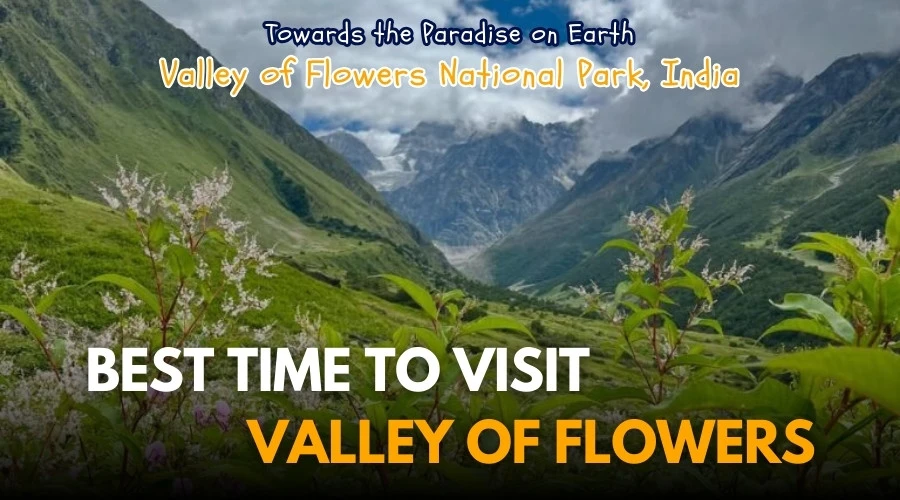
Leave a Comment